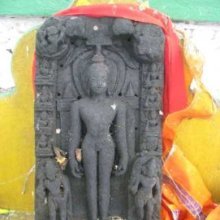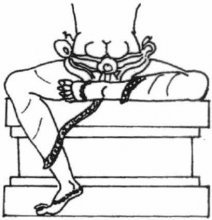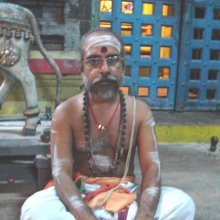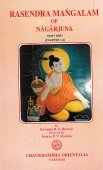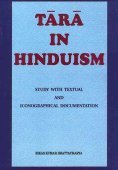Pitha, Pīṭha, Piṭha, Pītha, Pīṭhā: 41 definitions
Introduction:
Pitha means something in Buddhism, Pali, Hinduism, Sanskrit, Jainism, Prakrit, the history of ancient India, Marathi, Hindi, biology. If you want to know the exact meaning, history, etymology or English translation of this term then check out the descriptions on this page. Add your comment or reference to a book if you want to contribute to this summary article.
Alternative spellings of this word include Peeth.
Images (photo gallery)
In Hinduism
Shaivism (Shaiva philosophy)
Source: Wisdom Library: ŚaivismPīṭha (पीठ) refers to the “pedestal” of a liṅga. It is also known as piṇḍikā. The word liṅga refers to a symbol used in the worship of Śiva and is used thoughout Śaiva literature, such as the sacred Āgamas.
Source: Google Books: The Canon of the Śaivāgama and the The Kubjikā Tantras1) The word “pīṭha”, in a non-technical sense, means a stool, seat or bench and, by extension, the pedestal upon which an idol is installed. In the Tantras it commonly means a sacred place. In this present context, however, it means a “collection,” or “aggregate” (samūha) with reference to a group of scriptures and so denotes a class of Āgamas. It also signifies a range of matters that, taken collectively, concern a single Tantric topic. The two usages of the word are closely related: sometimes one applies, sometimes the other and, occasionally, both.
There are four pīṭhas, namely,
- Vidyā-pīṭha,
- Mantra-pīṭha,
- Mudrā-pīṭha and
- Maṇḍala-pīṭha.
2) According to Abhinava’s exposition of the division of the pīṭhas found in the Ānandaśāstra:
Source: Google Books: Manthanabhairavatantram (shaivism)‘Pīṭha’ [is a term referring] to a class [of Tantras]. It is of two types: right and left, called Mantra and Vidyā respectively, from which are derived the two associated with Mudrā and Maṇḍala.
Pīṭha (पीठ) or Pīṭhaka in the early Siddhāntāgamas denotes the “location of a deity”, sacred person or entity, [although] it not generally used to denote a sacred site. A pīṭha is a part of the maṇḍala where the deity sits. The Niḥśvāsatattvasaṃhitā refers to the central square of its primary maṇḍala as the pīṭha that is ‘the best of seats’. Similarly, the term pīṭha may denote the pedestal on which a Liṅga is placed and bathed (snānapīṭha) in a pavilion erected for that purpose. The same word also denotes the part of the plinth on which a Liṅga is erected. It may be of various kinds and variously named according to its size, shape, layers and the like. Such pīṭhas are described in the Siddhāntāgamas
Source: Brill: Śaivism and the Tantric TraditionsPīṭha (पीठ) refers to “external genital organ of the female partner”, according to the Brahmayāmala-tantra (or Picumata), an early 7th century Śaiva text consisting of twelve-thousand verses.—(Cf. Csaba Kiss, The Brahmayāmala or Picumata. Vol. II, 2015, 49, 47–48)

Shaiva (शैव, śaiva) or Shaivism (śaivism) represents a tradition of Hinduism worshiping Shiva as the supreme being. Closely related to Shaktism, Shaiva literature includes a range of scriptures, including Tantras, while the root of this tradition may be traced back to the ancient Vedas.
Purana and Itihasa (epic history)
Source: archive.org: Puranic EncyclopediaPīṭha (पीठ).—A demon. He was killed by Śrī Kṛṣṇa. (Śloka 5, Chapter 11, Droṇa Parva).
Source: Cologne Digital Sanskrit Dictionaries: The Purana IndexPīṭha (पीठ).—The commander of Mura's forces; killed by Kṛṣṇa.*
- * Bhāgavata-purāṇa X. 59. 12-14.

The Purana (पुराण, purāṇas) refers to Sanskrit literature preserving ancient India’s vast cultural history, including historical legends, religious ceremonies, various arts and sciences. The eighteen mahapuranas total over 400,000 shlokas (metrical couplets) and date to at least several centuries BCE.
Shilpashastra (iconography)
Source: Google Books: Elements of Hindu iconographyPīṭha (पीठ).—Liṅgas are almost always set up in pedestals known as the piṇḍikā or pīṭha. In a square pīṭha, which is the one commonly met with, the length of one side of it may be twice the length of the pūjābhāga, or equal to the total length of the liṅga; in other words two-thirds of or equal to the total length of the liṅga. The pīṭha, the length of whose side is equal to the total length of the liṅga is said to belong to the uttamottama class and that whose side is equal to two-thirds the total length of the liṅga, to the adhamādhama class.
These pedestals (pīṭha, or, piṇḍikā) may be square, oblongular, octogonal, elongated octagon, hexagon, elongated hexagon, duodecagon, elongated duodecagon, 16-sided, regular or elongated, circular, elliptical, triangular and semi-circular in plan.
Source: Shodhganga: Vaisnava Agamas And Visnu ImagesPīṭha (पीठ) refers to “pedestals”, as defined in treatises such as the Pāñcarātra, Pādmasaṃhitā and Vaikhānasa-āgamas, extensively dealing with the technical features of temple art, iconography and architecture in Vaishnavism.

Shilpashastra (शिल्पशास्त्र, śilpaśāstra) represents the ancient Indian science (shastra) of creative arts (shilpa) such as sculpture, iconography and painting. Closely related to Vastushastra (architecture), they often share the same literature.
Vastushastra (architecture)
Source: Wisdom Library: Vāstu-śāstraPīṭha (पीठ) refers to “pedestal”. It is sculptured as a part of the pillar (stambha).
Source: Shodhganga: Temples of Salem region Up to 1336 ADPīṭha (पीठ, “pedestal”).—Part of the pillar (stambha);—It is the lowest member of the pillar. It has three major functions:
- It gives a solid support to the shaft of the pillar.
- It adds height to the pillar.
- It enriches the beauty of the pillar.
Pedestals are also decorated with decorations like kapota punctuated with nāsis and sometimes also with scalloped lotus petals.
Source: OpenEdition books: Architectural terms contained in Ajitāgama and RauravāgamaPīṭha (पीठ) refers to “- 1. pedestal §§ 2.16; 3.1; 4.7, 28; 5.3-4. - 2. substitute altar (in place of an image of an Assessor) § 5.13. - 3. - mahāpīṭha §§ 5.11, 12.”.—(For paragraphs cf. Les enseignements architecturaux de l'Ajitāgama et du Rauravāgama by Bruno Dagens)

Vastushastra (वास्तुशास्त्र, vāstuśāstra) refers to the ancient Indian science (shastra) of architecture (vastu), dealing with topics such architecture, sculpture, town-building, fort building and various other constructions. Vastu also deals with the philosophy of the architectural relation with the cosmic universe.
Shaktism (Shakta philosophy)
Source: Google Books: Hinglaj DeviPīṭha (पीठ).—The term pīṭha (Skt. seat, altar) specifically describes holy sites relating to Goddess worship all over South Asia.
Source: Google Books: ManthanabhairavatantramPīṭha (पीठ) (“sacred seat”) is a general term for a place where a goddess or Yoginī resides. Internalized, these places may be represented as the ‘location’ of the fifty letters within the goddess’s triangular Yoni. When viewed in this form the Yoni is called the Meruprastāra. This is described in detail in chapter eight of the Kumārikākhaṇḍa.

Shakta (शाक्त, śākta) or Shaktism (śāktism) represents a tradition of Hinduism where the Goddess (Devi) is revered and worshipped. Shakta literature includes a range of scriptures, including various Agamas and Tantras, although its roots may be traced back to the Vedas.
Kavya (poetry)
Source: Brill: Śaivism and the Tantric Traditions (kavya)Pīṭha (पीठ) refers to the “seat (of the Goddess)”, according to Bāṇa’s Kādambarī (p. 225-226).—Accordingly, while describing the shire of the Goddess Caṇḍikā, “[Then follows the image of the Goddess Caṇḍikā, which matches the conception of Kālarātri in the passage from the Mahābhārata:] Her feet were never bereft of cloths [dyed with] red lac thrown upon the mound of her seat [on the altar] (piṇḍikā-pīṭha-pātin) as if they were the lives of all creatures arrived there for shelter; she resembled an inhabitant of the Underworld because of the intense darkness obstructed [only] by the flashes from axes, spears, etc., weapons deadly for beings, that seemed to hold nets of hair stuck from decapitations because of the reflections of black yak-tail whisks cast [upon their surfaces]; [...]”.

Kavya (काव्य, kavya) refers to Sanskrit poetry, a popular ancient Indian tradition of literature. There have been many Sanskrit poets over the ages, hailing from ancient India and beyond. This topic includes mahakavya, or ‘epic poetry’ and natya, or ‘dramatic poetry’.
Yoga (school of philosophy)
Source: Brill: Śaivism and the Tantric Traditions (yoga)Pīṭha (पीठ) refers to “seats (of deities)”, according to the Amṛtasiddhi, a 12th-century text belonging to the Haṭhayoga textual tradition.—Accordingly, “There are oceans, rivers, regions [and] guardians of the regions; gathering places, sacred sites, seats (pīṭha) [of deities and] the deities of the seats”.

Yoga is originally considered a branch of Hindu philosophy (astika), but both ancient and modern Yoga combine the physical, mental and spiritual. Yoga teaches various physical techniques also known as āsanas (postures), used for various purposes (eg., meditation, contemplation, relaxation).
Pancaratra (worship of Nārāyaṇa)
Source: archive.org: Catalogue of Pancaratra Agama TextsPīṭha (पीठ) refers to a “pedestal” or an “altar (e.g., for offerings)”, as discussed in the thirty-second chapter of the Aniruddhasaṃhitā, an ancient Pāñcarātra Āgama text dealing with the annual festivals of temples and regular temple worship routines.—Description of the chapter [bali-pīṭha-pratiṣṭhāpana-vidhi]: In the temple the four most important items are the central building [prāsada], the inner sanctuary [garbhagṛha], the pedestal [pīṭha] for the idol, and the idol [pratimā] itself (1-2). The altar for offerings [bali-pīṭha] located in front of the central building should be constructed so as to be proportionate with the size of the idol’s pedestal, and of the same materials (3-5). [...]

Pancaratra (पाञ्चरात्र, pāñcarātra) represents a tradition of Hinduism where Narayana is revered and worshipped. Closeley related to Vaishnavism, the Pancaratra literature includes various Agamas and tantras incorporating many Vaishnava philosophies.
In Buddhism
Tibetan Buddhism (Vajrayana or tantric Buddhism)
Source: Google Books: Manthanabhairavatantram (tantric buddhism)Pīṭha (पीठ) refers to a “sacred seat” and represents one of the various classes of sacred sites, according to the Netravibhaṅga, a commentary on the Hevajratantra by Dharmakīrti.—Accordingly, “It is called a ‘seat’ (pīṭha) because one always stays there and performs the practice, also because the yogis stay there. Because it is near to that place, it is called ‘nearby seat’ (upapīṭha). It is called ‘field’ (kṣetra), because it produces good qualities, also because the mother-goddesses stay there. Because it is near to there, it is called ‘near-by field’ (upakṣetra). Because one desires and yearns, it is called Chando. Because it is near there, it is called ‘near-by Chando’. It is called ‘meeting place’ (melāpaka) because it is the site of a place, [for example] Magadha and Aṅgamagadha. It is called ‘near-by meeting place’ because it is near there. It is called ‘cemetery’ (śmaśāna) because no discriminating thought (vikalpa) arises and because there are many corpses. It is called ‘near-by cemetery’, because it is near to there”.
Source: academia.edu: A Critical Study of the Vajraḍākamahātantrarāja (II)Pīṭha (पीठ) is one of the Pīṭhādis (group of districts) present within the Cittacakra (‘circle of mid’) which is associated with the Ḍākinī named Khecarī (‘a woman going in the sky’), according to the 9th-centruy Vajraḍākatantra.
The Pīṭhādi named Pīṭha within the Cittacakra contains the following four districts or seats:
- Pullīramalaya,
- Jālandhara,
- Oḍyāna,
- Arbuda.
Pīṭha (पीठ) refers to a type of power place where Yogins and Yoginīs congregate, according to the Sampuṭodbhavatantra chapter 5.—Accordingly, “[Vajragarbha asked:]—‘Blessed One, what places are places of gatherings?’ [The Blessed One said:]—‘There are pīṭhas and auxiliary pīṭhas, And likewise, kṣetras and auxiliary kṣetras. There are also chandohas and auxiliary chandohas, melāpakas and auxiliary melāpakas. There are charnel grounds and auxiliary charnel grounds, pīlavas and auxiliary pīlavas. These are the twelve types of meeting places. The lord of the ten bhūmis has not specified Any places other than these twelve’. [...]”.
Pīṭha in Tibetan: གནས། [gnas].
Source: OSU Press: Cakrasamvara SamadhiPīṭha (पीठ) refers to the “power places”, according to the Cakrasaṃvara Samādhi [i.e., Cakrasamvara Meditation] ritual often performed in combination with the Cakrasaṃvara Samādhi, which refers to the primary pūjā and sādhanā practice of Newah Mahāyāna-Vajrayāna Buddhists in Nepal.—Accordingly, “Drinking the only essence, the liquor of union, purifies the mind, By going to the power places (pīṭha—pīṭhādideśagamanena), and so on, the body is purified, In the middle of the holy seat, the highest mandala, Cakra Nātha, With the head bowed, in praise of the eternally highest Guru”.

Tibetan Buddhism includes schools such as Nyingma, Kadampa, Kagyu and Gelug. Their primary canon of literature is divided in two broad categories: The Kangyur, which consists of Buddha’s words, and the Tengyur, which includes commentaries from various sources. Esotericism and tantra techniques (vajrayāna) are collected indepently.
In Jainism
General definition (in Jainism)
Source: archive.org: TrisastisalakapurusacaritraPīṭha (पीठ) refers to one of the sons of king Vajrasena, according to chapter 1.1 [ādīśvara-caritra] of Hemacandra’s 11th century Triṣaṣṭiśalākāpuruṣacaritra: an ancient Sanskrit epic poem narrating the history and legends of sixty-three illustrious persons in Jainism.
Accordingly,
“in the continent Jambūdvīpa, in the East Videhas, in the province Puṣkalāvatī in the vicinity of the ocean, in the city Puṇḍarīkiṇī, they were born in succession as the five sons of King Vajrasena by his wife Dhāriṇī. [...] The souls of the sons of the merchant and trader were named Pīṭha and Mahāpīṭha”.
Pīṭha and Bāhu later incarnated as twins from Sumaṅgalā (one of Ṛṣabha’s wifes), as mentioned in chapter 1.2.—Accordingly,
Source: HereNow4u: Lord Vṛṣabhanātha“[...] when a little less than six pūrvas had passed after the wedding, while the Lord enjoyed himself with them, the Jīvas of Bāhu and Pīṭha fell from Sarvārthasiddhi and entered Sumaṅgalā’s womb as twins. Likewise the jīvas of Subāhu and Mahāpīṭha fell from Sarvārthasiddhi and entered Sunandā’s womb. [...] Sumaṅgalā bore children, Bharata and Brāhmī, as the east bears the sun and (morning) twilight lighting up the quarter of the sky”.
Pīṭha (पीठ) was one of the four friends and brother of Vajranābha: Vṛṣabhanātha’s eleventh incarnation (bhava).—After completing his life as a deva Jīvānanda was born in Puṣkalāvatī to the wife of king Vajrasena, Dharaṇī. At the time of conception the mother saw 14 great dreams. Vajrasena named his son Vajranābha, who went on to become a cakravartī (emperor). His four friends were born as his brothers Bāhu, Subāhu, Pīṭha and Mahāpīṭha and became provincial kings. When his father, Tīrthaṅkara Vajrasena, after attaining omniscience (kevalī), started delivering his religious sermons, the cakravartī Vajranābha (due to his past good merits) too accepted initiation (renounced the world).

Jainism is an Indian religion of Dharma whose doctrine revolves around harmlessness (ahimsa) towards every living being. The two major branches (Digambara and Svetambara) of Jainism stimulate self-control (or, shramana, ‘self-reliance’) and spiritual development through a path of peace for the soul to progess to the ultimate goal.
India history and geography
Source: Cologne Digital Sanskrit Dictionaries: Indian Epigraphical GlossaryPiṭha.—(Chamba), a grain measure; also spelt piḍā, peḍā, pyoḍā. Note: piṭha is defined in the “Indian epigraphical glossary” as it can be found on ancient inscriptions commonly written in Sanskrit, Prakrit or Dravidian languages.
--- OR ---
Pīṭha.—(CII 4; IA 12), receptacle of a Śiva-liṅga; the ablution trough of a Śiva-liṅga; also called Yoni-paṭṭa. (SITI), pedestal for the image of a deity. Note: pīṭha is defined in the “Indian epigraphical glossary” as it can be found on ancient inscriptions commonly written in Sanskrit, Prakrit or Dravidian languages.
Source: Shodhganga: Vernacular architecture of Assam with special reference to Brahmaputra ValleyPitha is an Assamese term referring to “the outer layer / rind of bamboo and strand prepared from outer layer”.—It appears in the study dealing with the vernacular architecture (local building construction) of Assam whose rich tradition is backed by the numerous communities and traditional cultures.

The history of India traces the identification of countries, villages, towns and other regions of India, as well as mythology, zoology, royal dynasties, rulers, tribes, local festivities and traditions and regional languages. Ancient India enjoyed religious freedom and encourages the path of Dharma, a concept common to Buddhism, Hinduism, and Jainism.
Biology (plants and animals)
Source: Google Books: CRC World Dictionary (Regional names)1) Pitha in India is the name of a plant defined with Sapindus emarginatus in various botanical sources. This page contains potential references in Ayurveda, modern medicine, and other folk traditions or local practices It has the synonym Sapindus emarginatus Hort. Alger. (among others).
2) Pitha is also identified with Sapindus trifoliatus It has the synonym Sapindus trifoliatus Turcz. (etc.).
Example references for further research on medicinal uses or toxicity (see latin names for full list):
· Taxon (1982)
· Catalogue des Plantes de Madagascar, Sapind. (1931)
· Rev. Hortic. (1895)
· Bulletin de la Société Imperiale des Naturalistes de Moscou (1863)
· Species Plantarum (1753)
If you are looking for specific details regarding Pitha, for example extract dosage, diet and recipes, health benefits, pregnancy safety, chemical composition, side effects, have a look at these references.

This sections includes definitions from the five kingdoms of living things: Animals, Plants, Fungi, Protists and Monera. It will include both the official binomial nomenclature (scientific names usually in Latin) as well as regional spellings and variants.
Languages of India and abroad
Pali-English dictionary
Source: BuddhaSasana: Concise Pali-English Dictionarypīṭha : (nt.) chair; a seat.
Source: Sutta: The Pali Text Society's Pali-English DictionaryPīṭha, (nt.) (cp. Fpic Sk. pīṭha) a seat, chair, stool, bench.—4. kinds are given at Vin. IV, 40=168, viz. masāraka, bundikābaddha, kuḷirapādaka, āhaccapādaka (same categories as given under mañca).—Vin. I, 47, 180; II, 114, 149, 225; A. III, 51 (mañca°, Dvandva); IV, 133 (ayo°); Ps. I, 176; Vv 11 (see discussed in detail at VvA. 8); VvA. 295 (mañca°).—pāda° footstool J. IV, 378; VvA. 291; bhadda° state-chair, throne J. III, 410.—sappin “one who crawls by means of a chair or bench, ” i.e. one who walks on a sort of crutch or support, a cripple (pīṭha here in sense of “hatthena gahana-yogga” VvA. 8; exlpd by Bdhgh as “chinn’iriyāpatha” Vin. Texts I. 225) J. I, 76, 418; V, 426 (khujja+) VI, 4, 10; Miln. 205, 245, 276; Vism. 596 (& jaccandha, in simile); DhA. I, 194; II, 69; PugA 227; PvA. 282. (Page 461)

Pali is the language of the Tipiṭaka, which is the sacred canon of Theravāda Buddhism and contains much of the Buddha’s speech. Closeley related to Sanskrit, both languages are used interchangeably between religions.
Marathi-English dictionary
Source: DDSA: The Molesworth Marathi and English Dictionarypiṭhā (पिठा).—m (A Bombay-word). A spirit-shop, or a liquor-tavern.
--- OR ---
piṭhā (पिठा).—a (pīṭha) Gritty, friable, crumbling--sorts of stone &c. 2 Clammy; like badly-baked dough--the pulp of certain fruits.
--- OR ---
pīṭha (पीठ).—n (piṣṭa S) Meal in general except that of wheat, which, par excellence, is termed kaṇīka (from kaṇa). Applied, sometimes however, to wheaten meal. 2 fig. Crushed, crumbled, ruined state: also defeated or overcome state: also the state of utter expenditure or dissipation, of consumption or exhaustion, of whatever subject or of whatever specific character. Used largely as its derivative piṭhāḍa, or as cūra, curāḍā, dhūḷa, mātī, rākha &c. &c. 3 Used enhancingly after gōrā; as gōrā gōrā pīṭha Surpassingly fair. 4 Used as ad in the sense Clearly and brightly of the shining of the moon. v paḍa; as cāndaṇēṃ pīṭha paḍatēṃ.
--- OR ---
pīṭha (पीठ).—n (S) A stool, a low chair or seat. 2 The seat of the religious student, made of the grass kuśa. 3 pīṭhaṃ, in the sense of Seat or spot of eminent residence or abiding, forms compounds such as gurupīṭha, vidyāpīṭha, rājapīṭha. 4 also pīṭhasthāna n A place where a limb of Parvati is supposed to have fallen when her dead body was cut to pieces by the cakra of viṣṇu. There are fifty-one such places. See mahāpīṭha.
Source: DDSA: The Aryabhusan school dictionary, Marathi-Englishpiṭhā (पिठा).—m A spirit-shop, or a liquor-tavern.
--- OR ---
piṭhā (पिठा).—a Gritty, crumbling. Clammy.
--- OR ---
pīṭha (पीठ).—n Meal. Crushed, or ruined state. ādhī piṭhōbā (pōṭōbā) maga viṭhōbā Let us satisfy the belly, then we'll think of worship.
--- OR ---
pīṭha (पीठ).—n A low chair. The seat, as gurupīṭha, vidyāpīṭha, rājapīṭha. See mahāpīṭha.
Marathi is an Indo-European language having over 70 million native speakers people in (predominantly) Maharashtra India. Marathi, like many other Indo-Aryan languages, evolved from early forms of Prakrit, which itself is a subset of Sanskrit, one of the most ancient languages of the world.
Sanskrit dictionary
Source: DDSA: The practical Sanskrit-English dictionaryPiṭha (पिठ).—Affliction, distress.
Derivable forms: piṭhaḥ (पिठः).
--- OR ---
Pīṭha (पीठ).—
1) A seat (a stool, chair, bench, sofa &c.); जवेन पीठादुदतिष्ठदच्युतः (javena pīṭhādudatiṣṭhadacyutaḥ) Śiśupālavadha 1.12; R,4.84;6.15.
2) The seat of a religious student made of Kuśa grass.
3) The seat of a deity, an altar.
4) A pedestal in general, basis.
5) A particular posture in sitting.
6) (In geometry) The complement of a segment.
7) Name of various temples; पीठं जालंधरं नाम तिष्ठत्यत्र चतुर्मुख (pīṭhaṃ jālaṃdharaṃ nāma tiṣṭhatyatra caturmukha) Yoga- śikhopaniṣad, 5.11.
8) A royal seat, throne.
9) A district, province.
Derivable forms: pīṭham (पीठम्).
--- OR ---
Pītha (पीथ).—1 The sun.
2) Time.
3) Fire.
4) Protection.
5) Drink; यस्याध्वरे भगवानध्वरात्मा मघोनि माद्यत्युरुसोमपीथे (yasyādhvare bhagavānadhvarātmā maghoni mādyatyurusomapīthe) Bhāgavata 5.15.12.
-tham 1 Water.
2) Ghee.
Derivable forms: pīthaḥ (पीथः).
Source: Cologne Digital Sanskrit Dictionaries: Shabda-Sagara Sanskrit-English DictionaryPiṭha (पिठ).—m.
(-ṭhaḥ) Pain, distress. E. piṭha, and ka aff.
--- OR ---
Pīṭha (पीठ).—mfn.
(-ṭhaḥ-ṭhī-ṭhaṃ) 1. A stool, a seat, a chair. 2. The seat of the religious student, made properly of Kuśa grass. 3. A place where some limb of Parvati is supposed to have fallen, as after Daksha’s sacrifice, her dead body was carried about by Siva, and cut in pieces by the discus of Vishnu: there are fifty-one such places. 4. Complement of a segment, (in Geometry.) 5. A pedestal. 6. A particular posture in sitting. E. piṭh to be weary, to feel pain, aff. ghañ; deriv. irr. or pā-ṭhak piṭha-ka vā pṛṣo0 dīrghaḥ .
--- OR ---
Pītha (पीथ).—m.
(-thaḥ) 1. The sun. 2. Fire. 3. Time. n.
(-thaṃ) Water. E. pā to drink, Unadi aff. thak, and the radical vowel changed.
Source: Cologne Digital Sanskrit Dictionaries: Benfey Sanskrit-English DictionaryPīṭha (पीठ).— n. and m. 1. A stool, a seat, a chair, Mahābhārata 5, 1399; a bench. 2. A base or pedestal, [Rājataraṅgiṇī] 2, 126. 3. The seat of a deity, an altar, [Rājataraṅgiṇī] 5, 46; 473. 4. A kind of ornament, [Harivaṃśa, (ed. Calc.)] 8063.
--- OR ---
Pītha (पीथ).—i. e. 1. pā + tha, I. m. A drink. Ii. n. Water.
Source: Cologne Digital Sanskrit Dictionaries: Cappeller Sanskrit-English DictionaryPīṭha (पीठ).—[neuter] seat, stool, bench, pedestal.
--- OR ---
Pītha (पीथ).—[masculine] drink or protection.
Source: Cologne Digital Sanskrit Dictionaries: Monier-Williams Sanskrit-English Dictionary1) Piṭha (पिठ):—[from piṭh] m. pain, distress, [Horace H. Wilson]
2) Pīṭha (पीठ):—n. (rarely f(ī). ; possibly corrupted [from] pi-sad, to sit upon) a stool, seat, chair, bench, [Gṛhya-sūtra; Mahābhārata] etc.
3) a religious student’s seat (made properly of Kuśa grass), [Horace H. Wilson]
4) case, pedestal ([especially] of an idol), [Rājataraṅgiṇī; Varāha-mihira [Scholiast or Commentator]]
5) royal seat, throne, [Rāmatāpanīya-upaniṣad]
6) place, office (cf. pīṭhādhikāra)
7) Name of various temples (erected on the 5 1 spots where the limbs of Pārvatī fell after she had been cut to pieces by the discus of Viṣṇu), [cf. Lexicographers, esp. such as amarasiṃha, halāyudha, hemacandra, etc.]
8) a district, province, [Pañcatantra]
9) a [particular] posture in sitting, [Catalogue(s)]
10) (in [geometry]) the complement of a segment, [Colebrooke]
11) m. a kind of fish, [cf. Lexicographers, esp. such as amarasiṃha, halāyudha, hemacandra, etc.]
12) the sun, [Demetrius Galanos’s Lexiko: sanskritikes, anglikes, hellenikes]
13) Name of an Asura, [Mahābhārata]
14) of a minister of Kaṃsa, [Harivaṃśa]
15) Pītha (पीथ):—[from pīta] 1. pītha m. a drink, draught (cf. go-p, surā-p, soma-p)
16) [v.s. ...] n. water, [cf. Lexicographers, esp. such as amarasiṃha, halāyudha, hemacandra, etc.]
17) [v.s. ...] melted butter, [cf. Lexicographers, esp. such as amarasiṃha, halāyudha, hemacandra, etc.]
18) [from pīti] 2. pītha m. idem (See go-p).
Source: Cologne Digital Sanskrit Dictionaries: Yates Sanskrit-English Dictionary1) Piṭha (पिठ):—(ṭhaḥ) 1. m. Pain.
2) Pīṭha (पीठ):—[(ṭhaḥ-ṭhī-ṭhaṃ) a.] A stool, a seat of kusa grass; a sacred spot; complement of a segment.
3) Pītha (पीथ):—(thaḥ) 1. m. Idem; time. n. Water.
Source: DDSA: Paia-sadda-mahannavo; a comprehensive Prakrit Hindi dictionary (S)Pīṭha (पीठ) in the Sanskrit language is related to the Prakrit word: Pīḍha.
[Sanskrit to German]
Sanskrit, also spelled संस्कृतम् (saṃskṛtam), is an ancient language of India commonly seen as the grandmother of the Indo-European language family (even English!). Closely allied with Prakrit and Pali, Sanskrit is more exhaustive in both grammar and terms and has the most extensive collection of literature in the world, greatly surpassing its sister-languages Greek and Latin.
Hindi dictionary
Source: DDSA: A practical Hindi-English dictionaryPīṭha (पीठ) [Also spelled peeth]:—(nf) the back; spine; (nm) a seat; an institute; —[kā/-para kā] born next in succession; —[cārapāī se laganā] to be bedridden; to be confined to bed; to be reduced to skeleton; —[ṭhokanā] to pat on the back appreciatively; to praise; to give encouragement; —[dikhānā] to show the white feather, to turn tails, to flee from the battlefield; —[denā] to turn tails, to flee, to part company (in a venture); —[para hātha pheranā] to part appreciatively, to give encouragement, —[para hātha rakhanā] to support; —[para honā] to be at the back of; —[pīche, ke] in the absence of; —[pheranā] to turn one’s back upon; —[meṃ churā ghoṃpanā/bhoṃkanā] to stab in the back, to play (one) foul; —[meṃ chūla/miṭṭī milanā] to be felled, to suffer defeat; —[moḍanā] to turn to go, to leave the scene; —[laganā, kisī kī] to be defeated (in Indian style wrestling); to be thrown flat on the back; —[sahalānā] to soothe.
...
Kannada-English dictionary
Source: Alar: Kannada-English corpusPīṭha (ಪೀಠ):—
1) [noun] a piece of furniture to sit on; a seat.
2) [noun] a solid base on which an idol is placed, installed, etc.
3) [noun] a small, circular platform for keeping the offferings made to a god.
4) [noun] the supporting part of the wall, which usu. lies below the surface of the earth; foundation; basement.
5) [noun] the office, authority of a religious pontifs or political leaders.
6) [noun] a centre for education (as a school, university, etc.).
7) [noun] a facility created in a university or research centre, for studying a subject or conducting a research on a particular discipline of knowledge.
Kannada is a Dravidian language (as opposed to the Indo-European language family) mainly spoken in the southwestern region of India.
See also (Relevant definitions)
Starts with (+185): Pita, Pita-cimmakatosham, Pitacalam, Pitacaram, Pitai, Pitakam, Pitakan, Pitakantam, Pitakarakam, Pitakattam, Pitakavatai, Pitakaveram, Pitaki, Pitakkal, Pitalai, Pitalakam, Pitalam, Pitamaki, Pitamani, Pitamukam.
Ends with (+184): Abjapitha, Acarya-pitha, Adipitha, Adityapitha, Adyapitha, Agrapitha, Aishrvaryapitha, Amburutpitha, Amkapitha, Amsapitha, Anamtapitha, Anandapitha, Antahpitha, Apisomopitha, Apita, Aripitha, Ashtapadaripupitha, Ashtapitha, Atanapitha, Attasomapitha.
Full-text (+1043): Padapitha, Devikota, Pithaka, Purnagiri, Pithasarpin, Pugapitha, Bhadrapitha, Pithakeli, Pithanyasa, Kamarupa, Oddiyana, Jalandhara, Varanasi, Pithaga, Pithasarpa, Pithacakra, Devikotta, Dharmapitha, Simhagiri, Pithasthana.
Relevant text
Search found 82 books and stories containing Pitha, Peetha, Pīṭha, Piṭhā, Piṭha, Pītha, Pīṭhā; (plurals include: Pithas, Peethas, Pīṭhas, Piṭhās, Piṭhas, Pīthas, Pīṭhās). You can also click to the full overview containing English textual excerpts. Below are direct links for the most relevant articles:
Samarangana-sutradhara (Summary) (by D. N. Shukla)
Chapter 71 - Iconography of the Phalli (liṅga) and their Pedestals (pīṭha)
Chapter 25 - The Measurement of the Pedestal (Pīṭhamāna)
Chapter 63-64 - The five-fold terraces (Pīṭha-pañcaka) and Drāviḍa Prāsāda
Chaitanya Bhagavata (by Bhumipati Dāsa)
Verse 3.2.495 < [Chapter 2 - Description of the Lord’s Travel Through Bhuvaneśvara and Other Placesto Jagannātha Purī]
Verse 3.1.64 < [Chapter 1 - Meeting Again at the House of Śrī Advaita Ācārya]
Verse 3.2.401 < [Chapter 2 - Description of the Lord’s Travel Through Bhuvaneśvara and Other Placesto Jagannātha Purī]
Stupas in Orissa (Study) (by Meenakshi Chauley)
Uddiyana Pitha (in Tantric Buddhism) < [Chapter 2]
Sahajayana (in Tantric Buddhism) < [Chapter 2]
Stupas in Orissa (Introduction) < [Chapter 4]
Preceptors of Advaita (by T. M. P. Mahadevan)
59. Śrī Kāmakoṭi Pīṭha and Śrī Śaṅkarāchārya
57. Śrī Śaṅkara And Śaṅkarite Insitutions
(ii) Kāmakoṭi and Nayanmars < [58. (various)]
The Skanda Purana (by G. V. Tagare)
Chapter 132 - Greatness of Siddhalakṣmī < [Section 1 - Prabhāsa-kṣetra-māhātmya]
Chapter 35 - Installation of Citreśvara Pītha < [Section 1 - Tīrtha-māhātmya]
Chapter 189 - Greatness of Karmamotī < [Section 1 - Prabhāsa-kṣetra-māhātmya]
Cidgaganacandrika (study) (by S. Mahalakshmi)
Verse 298 [Cakranavaka] < [Chapter 4 - Fourth Vimarśa]
Verse 260 [Human body is Śakti’s] < [Chapter 4 - Fourth Vimarśa]
Verse 300 [Śambhava-Śākta-Guru kramas] < [Chapter 4 - Fourth Vimarśa]
Related products
